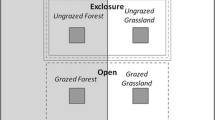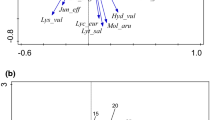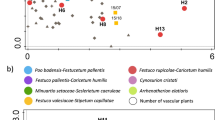Abstract
Understanding responses of both dominant and sub-dominant plant speciesto management regimes and climatic variables is a critical component ofunderstanding an ecosystem's potential response to local or regional changes insuch parameters. The dominant vegetation of much of the North Americantallgrassprairie is composed of C4 grasses. As the most abundant species,Andropogon gerardii has been well characterizedecologically. The second most abundant, co-dominant species,Sorghastrum nutans, has received less attention, mainlybecause it has been considered the “ecological equivalent” ofA. gerardii and is assumed to have responses similar tothose of A. gerardii. The objective of this study was toassess the validity of this assumption by examining long-term abundancepatternsand responses to climate, fire, and grazing for both species. Based on 15 years(1983–1997) of plant species composition and cover data collected atKonzaPrairie Biological Station in northeastern Kansas, USA, we were able to detectimportant differences between these two grasses. Regression analysis showedthatlong-term reductions in the cover of A. gerardii werecorrelated with decreasing summer maximum temperatures, whereas inter-annualvariations in the cover of S. nutans were related toannualprecipitation. Additionally, the cover of S. nutansincreased with increasing fire frequency, while the cover of A.gerardii was not significantly affected by fire frequency. Bisongrazing did not significantly affect the cover of either species studied. Themean cover of A. gerardii decreased significantly over the15 years, but only a slight change was noted in the cover of S.nutans. The decrease in A. gerardiicorrespondedto increased plant species diversity and evenness and has the potential toimpact the tallgrass prairie ecosystem from population through ecosystemlevels.The observed differences in these co-dominant species may prove important underclimate change scenarios predicted for the tallgrass prairie of North America.
Similar content being viewed by others
References
Abrams M.D. and Hulbert L.C. 1987. Effect of topographic position and fire on species composition in a tallgrass prairie in northeast Kansas. American Midland Naturalist 117: 442–445.
Alward R.D., Detling J.K. and Milchunas D.G. 1999. Grassland vegetation changes and nocturnal global warming. Science 283: 229–231.
Bark L.D. 1987. Konza Prairie Research Natural Area, Kansas. In: Greenwood D. (ed.), The Climate of Long-Term Ecological Research Sites. (Occasional Paper 44). Institute for Arctic and Alpine Research, University of Colorado, Boulder, pp. 45–50.
Berendse F., Oudhof H. and Bol J. 1987. A comparative study on nutrient cycling in wet heathland ecosystem. I. Litter production and nutrient losses from the plant. Oecologia 74: 174–184.
Bobbink R. and Willems J.H. 1987. Increasing dominance of Brac-hypodium pinnatum (L.) Beauv. in chalk grasslands: a threat to a species-rich system. Biological Conservation 40: 301–314.
Collins S.L. and Gibson D.J. 1990. Effects of fire on community structure in tallgrass and mixed-grass prairie. In: Collins S.L. and Wallace L.L. (eds), Fire in North American Tallgrass Prairie. University of Oklahoma Press, Norman, OK, pp. 81–98.
Collins S.L. and Glenn S.M. 1991. Importance of spatial and temporal dynamics in species regional abundance and distribution. Ecology 72: 654–664.
Collins S.L. and Steinauer E.M. 1998. Disturbance, diversity, and species interactions in tallgrass prairie. In: Knapp A.K., Briggs J.M., Hartnett D.C. and Collins S.L. (eds), Grassland Dynamics: Long-term Ecological Research in Tallgrass Prairie. Oxford University Press, New York, NY, pp. 140–158.
Coppedge B.R., Engle D.M.C., Toepfer S. and Shaw J.H. 1998. Effects of seasonal fire, bison grazing and climatic variation on tallgrass prairie vegetation. Plant Ecology 139: 235–246.
Daubenmire R.F. 1959. A canopy coverage method of vegetational analysis. Northwest Science 33: 43–66.
DeLucia E.H., Heckathorn S.A. and Day T.A. 1992. Effects of soil temperature on growth, biomass allocation, and resource acquisition of Andropogon gerardii Vitman. New Phytologist 120: 543–549.
Epstein H.E., Lauenroth W.K., Burke I.C. and Coffin D.P. 1996. Ecological responses of dominant grasses along two climatic gradients in the great plains of the United States. Journal of Vegetation Science 7: 777–788.
Epstein H.E., Lauenroth W.K., Burke I.C. and Coffin D.P. 1998. Regional productivities of plant species in the Great Plains of the United States. Plant Ecology 134: 173–195.
Fay P.A., Carlisle J.D., Knapp A.K., Blair J.M. and Collins S.L. 2000. Altering rainfall timing and quantity in a mesic grassland ecosystem: design and performance of rainfall manipulation shelters. Ecosystems 3: 308–319.
Freeman C.C. 1998. The flora of Konza Prairie: a historical review and contemporary patterns. In: Knapp A.K., Briggs J.M., Hartnett D.C. and Collins S.L. (eds), Grassland Dynamics: Long-term Ecological Research in Tallgrass Prairie. Oxford University Press. New York, NY, pp. 69–80.
Gibson D.L. and Hulbert L.C. 1987. Effects of fire, topography and year-to-year climatic variation of species composition in tallgrass prairie. Vegetatio 72: 175–185.
Glenn-Lewin D.C., Johnson L.A., Jurik T.W., Akey A., Leoschke M. and Rosberg T. 1990. Fire in Central North American Grass-lands: Vegetative reproduction, seed germination, and seedling establishment. In: Collins S.C. and Wallace L.L. (eds), Fire in North American Tallgrass Prairie. University of Oklahoma Press, Norman, OK, pp. 28–45.
Grime J.P. 1998. Benefits of plant diversity to ecosystems: immediate, filter and founder effects. Journal of Ecology 86: 902–910.
Hadley E.B. and Kieckhefer B.J. 1963. Productivity of two prairie grasses in relation to fire frequency. Ecology 44: 389–395.
Hartnett D.C., Hickman K.R. and Walter L.E.F. 1996. Effects of bison grazing, fire, and topography on floristic diversity in tallgrass prairie. Journal of Range Management 49: 413–420.
Hartnett D.C. and Fay P.A. 1998. Plant populations: patterns and processes. In: Knapp A.K., Briggs J.M., Hartnett D.C. and Collins S.L. (eds), Grassland Dynamics: Long-term Ecological Research in Tallgrass Prairie. Oxford University Press, New York, NY, pp. 81–100.
Hobbie S. 1992. Effects of plant species on nutrient cycling. TREE 7: 336–339.
Hobbs R.J. and Mooney H.A. 1995. Spatial and temporal variability in California annual grassland: results from a long-term study. Journal of Vegetation Science 6: 43–56.
Hulbert L.C. 1988. Causes of fire effects in tallgrass prairie. Ecology 69: 46–58.
Kaufman D.W., Finck E.J. and Kaufman G.A. 1990. Small mammals and grassland fires. In: Collins S.L. and Wallace L.L. (eds), Fire in North American Tallgrass Prairie. University of Oklahoma Press, Norman, OK, pp. 46–80.
Knapp A.K. 1984. Water relations and growth of three grasses during wet and drought years in a tallgrass prairie. Oecologia 65: 35–43.
Knapp A.K. 1985. Effect of fire and drought on the ecophysiology of Andropogon gerardii and Panicum virgatum in a tallgrass prairie. Ecology 66: 1309–1320.
Knapp A.K. and Gilliam F.S. 1985. Response of Andropogon gerardii (Poaceae) to fire-induced high vs. low irradiance environments in tallgrass prairie: leaf structure and photosynthetic pigments. American Journal of Botany 72: 1668–1671.
Knapp A.K. and Seastedt T.R. 1986. Detritus accumulation limits productivity of tallgrass prairie. BioScience 36: 662–668.
Knapp A.K. and Seastedt T.R. 1998. Grasslands, Konza Prairie, and long-term ecological research. In: Knapp A.K., Briggs J.M., Hartnett D.C. and Collins S.L. (eds), Grassland Dynamics: Long-term Ecological Research in Tallgrass Prairie. Oxford University Press, New York, NY, pp. 3–18.
Knapp A.K., Blair J.M. and Briggs J.M. 1998. Long-term ecological consequences of varying fire frequency in a humid grass-land. In: Pruden T.L. and Brennan L.A. (eds), Fire in Ecosystem Management: Shifting the Paradigm from Suppression to Prescription. Tall Timbers Fire Ecology Conference Proceedings 20, pp. 173–178.
Knapp A.K., Briggs J.M., Blair J.M. and Turner C.L. 1998. Patterns and controls of aboveground net primary production in tallgrass prairie. In: Knapp A.K., Briggs J.M., Hartnett D.C. and Collins S.L. (eds), Grassland Dynamics: Long-term Ecological Research in Tallgrass Prairie. Oxford University Press, New York, NY, pp. 193–221.
Kucera C.L. and Koelling M. 1964. The influence of fire on composition of central Missouri prairie. American Midland Naturalist 72: 142–147.
Levine J.M. 1999. Indirect facilitation: evidence and predictions from a riparian community. Ecology 80: 1762–1769.
Magurran A.E. 1988. Ecological Diversity and its Measurement. Princeton University Press, Princeton, NJ.
McAllister C.A., Knapp A.K. and Maragni L.A. 1998. Is leaf-level photosynthesis related to plant success in a highly productive grassland? Oecologia 117: 40–46.
Polley H.W., Norman J.M., Arkebauer T.J., Walter-Shea E.A., Greegor D.H. Jr. and Bramer B. 1992. Leaf gas exchange of Andropogon gerardii Vitman, Panicum virgatum L., and Sorghastrum nutans (L.) Nash in a tallgrass prairie. Journal of Geophysical Research 97: 18837–18844.
Ransom M.D., Rice C.W., Todd T.C. and Wehmueller W.A. 1998. Soils and soil biota. In: Knapp A.K., Briggs J.M., Hartnett D.C. and Collins S.L. (eds), Grassland Dynamics: Long-term Ecological Research in Tallgrass Prairie. Oxford University Press, New York, NY, pp. 48–68.
SAS Institute Inc. 1997. SAS/STAT software: Changes and Enhancements through Release 6.12. SAS Institute Inc, Cary, North Carolina.
Silletti A.M. and Knapp A.K. 2001. Responses of the codominant grassland species Sorghastrum nutans and Andropogon gerardii to long-term manipulations of nitrogen and water. American Midland Naturalist 145: 159–167.
Smith M.D. and Knapp A.K. 1999. Exotic plant species in a C4-dominated grassland: invasability, disturbance, and community structure. Oecologia 120: 605–612.
Svejcar T.J. 1990. Response of Andropogon gerardii to fire in the tallgrass prairie. In: Collins S.L. and Wallace L.L. (eds), Fire in North American Tallgrass Prairies. University of Oklahoma Press, Norman, OK, pp. 19–27.
Svejcar T.J. and Browning J.A. 1988. Growth and gas exchange of Andropogon gerardii as influenced by burning. Journal of Range Management 41: 239–244.
Vinton M.A. and Collins S.L. 1996. Landscape heterogeneity gradients and habitat structure in native grasslands of the central Great Plains. In: Knopf F.L. and Samson F.B. (eds), Ecology of the Great Plains Vertebrates and their Habitats. Springer-Verlag, New York, NY, pp. 3–19.
Vitousek P.M., Aber J.B., Howarth R.W., Likens G.E., Matson P.A., Schindler D.W. et al. 1997. Human alterations of the global nitrogen cycle: sources and consequences. Ecological Applications 7: 737–750.
Wallace L.L. 1990. Comparative photosynthetic responses of big bluestem to clipping versus grazing. Journal of Range Management 43: 58–61.
Weaver J.E. 1931. Who's who among the prairie grasses. Ecology 12: 623–632.
Weaver J.E. and Fitzpatrick T.J. 1932. Ecology and relative importance of the dominants of tallgrass prairie. Botanical Gazette 93: 113–150.
Wedin D.A. and Tilman D. 1990. Species effects on nitrogen cycling: a test with perennial grasses. Oecologia 84: 433–441.
Author information
Authors and Affiliations
Rights and permissions
About this article
Cite this article
Silletti, A., Knapp, A. Long-term responses of the grassland co-dominants Andropogon gerardii and Sorghastrum nutans to changes in climate and management. Plant Ecology 163, 15–22 (2002). https://doi.org/10.1023/A:1020320214750
Issue Date:
DOI: https://doi.org/10.1023/A:1020320214750




